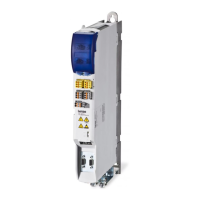Function library
Working with function blocks
9-39
L
EDSVS9332S-D11 EN 3.0
9 Function library
9.1 Working with function blocks
The signal flow of the controller can be configured by connecting function blocks. The controller can
thus be easily adapted to diverse applications.
9.1.1 Signal types
Each function block is provided with a certain number of inputs and outputs which can be interlinked.
Corresponding to itsrespectivefunctiononly particular signal types occur at theinputs and outputs:
z Quasi analog signals
–Symbol:
–Unit:%
–Designation:a
– Value range: ±16384 = ±100 %
– Resolution: 16 bits, rating ±16384 ≙ ±100 %
z Digital signals
–Symbol:
– Unit: binary, with HIGH or LOW level
–Designation:d
– Resolution: 1 bit
z Speed signals
–Symbol:
– Unit: rpm (for display, internal representation in [inc/ms])
– Designation: phd
– Value range: ±2
15
-1
– Resolution: 16 bit
z Phase signals
–Symbol:
–Unit:inc
–Designation:ph
– Value range: ±2
31
-1
– Resolution: 32 bits, rating 1 revolution ≙ 65536 inc
Only the same signal types can be connected with each other. Thus, an analog output signal of one
function block can only be connected to the analog output of the other function block. If two different
signal types are connected, the connection will be rejected.

